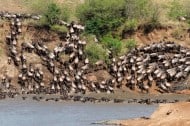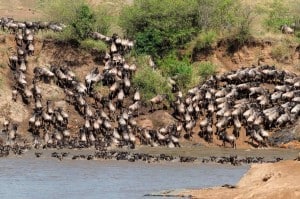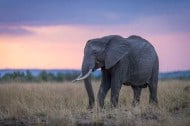
The History of the Masai Mara Animals
The History of the Masai Mara Animals
Our world is fascinated with diversity.
Being able to experience something that is even remotely different than the norm fuels the human spirit. We want to be wowed. We want to be entertained. We want to be inspired.
The Masai Mara National Reserve is one of those types of experiences. Being home to over 95 species of mammals and more than 400 species of birds, this Kenyan National Reserve offers an adventure of a lifetime.
Witnessing the myriad of Masai Mara animals is a breathtaking moment. Getting close to nature and seeing the Animal Kingdom in its natural habitat is something everyone needs to experience.
Before you become an avid spectator of these incredible creatures, here’s a bit of history about the Masai Mara animals.
The Masai Mara Animals Mecca
Being able to witness some of the most incredible animals on the planet, trekking through the Masai Mara National Preserve allows spectators to see an array of mammals that cannot be seen anywhere else in the world.

Earning its name from the Maasai people of Africa, the term ‘Mara’ means ‘spotted’ which perfectly describes the area. ‘Spotted’ with umbrella Acacia trees, bushes, and animals, this Kenyan preserve is a breeding ground for some of the most powerful, graceful, and unique animals to ever walk the Earth.
Let me introduce you to our animals and their stories.
The Big Five
Quite possibly, you probably recognize these animals as they are the creatures most associated with Africa. The lion, leopard, African elephant, cape buffalo, and black rhinoceros create this group of Masai Mara animals.
The name ‘The Big Five’ originated from hunters who claimed these animals were the most difficult and dangerous to hunt and kill. Nowadays, the name has evolved into meaning the main five animals that tourists and safari enthusiasts are hoping and expecting to see when visiting the reserve.
The Lion
Once found to be living in Africa, Asia, and Europe – this Big Five mammal, now, only exists in Africa.
With a roar that can be heard from over 5 miles away, this is one of the most exciting animals to see while touring the Masai Mara Reserve. Being able to see the ‘king of the Jungle’ wander in his natural home will be an experience like no other.
The Leopard
Make sure to look in the trees and even in the water to see this big cat. However, being the nocturnal one of the ‘Big Five’ Masai Mara animals, chances of seeing the leopard are pretty slim.
The African Elephant
Known as the largest creature that currently walks the planet, the African elephant is a sight to see. Wandering through 37 African countries, this mega mammal is separated into two breeds: the Savanna and the Forest.
The Savanna African elephant wanders through the bush of the continent. The Forest African elephant seems to stick around the Congo basin. Sadly, though, the Forest African elephant is on the decline due to poaching.
The Cape Buffalo
This cow-like buffalo with curved horns are native only to Africa. Able to live in almost every type of habitat, this Big Five species is one of the Masai Mara animals that thrives the most on the African continent.
Needing only grass to survive, chances of seeing this creature are pretty strong while touring through the reserve. Just don’t try to approach the Cape Buffalo – they are a pretty dangerous breed.
The Black Rhinoceros
Originally regarded as vermin that should be killed and disposed of at all costs by European hunters and settlers, this Big Five animal is working hard to make a comeback from its close-to-extinction status.
Currently, there are only estimated to be over 5,000 black rhinoceros left on this planet.
The Great Wildebeest Migration
If you’ve ever seen a migration of animals, then you know the overwhelming awe that exists when witnessing a mass number of animals walking together to a new location.
Chances are, though, that you’ve never seen anything like the Great Wildebeest Migration that happens on an annual basis. Consisting of over 1500 Serengeti wildebeests, zebra, Grant’s gazelles, Thomas’ gazelles, elands, and impalas – this massive migration is mesmerizing.
In late November-early December, the hoards of these Masai Mara animals trek south for a few months. In April, the gang moves northward.
Hippos vs The Nile Crocs
These two relatively opposite creatures cohabitate the same water space in the Masai Mara.
The Hippos stay cool in the waters of the Masai Mara, while the Nile crocodiles keep a low profile during the hot days. However, when the Nile croc gets hungry – any bathing animal becomes prey, as well as any animal that dares cross their watery home.
The Birds
With over 400 species of winged creatures that have been recorded in the Masai Mara, this is a huge draw for those looking to bird watch. Some of the most elusive and rare birds spend a bit of time on the reserve. It’s always exciting to see which of these birds may land and allow spectators to bask in their beauty.
Make a Trip to the Masai Mara a Reality
With histories that date back to the beginning of time, the Masai Mara animals are some of the most incredible creatures to witness on this planet.
Seeing the big cats, the massive mammals, and the myriad of birds that exist in this African reserve can offer an experience like no other. Being able to see the creatures of the Animal Kingdom interact together in their natural habitats is an opportunity that anyone should take.
The best way to witness these incredible sights is through a safari adventure or a hot air balloon aerial journey. However, you’ll want to ensure that you choose the right safari that will take you on the perfect Masai Mara tour.
Make sure to find the best travel opportunity that will allow you to see the Masai Mara animals up close and in their natural habitats.
Not sure how to make this travel dream become a reality? Contact an expert in the field that knows all the important and necessary information to make a trip to the Masai Mara an incredible and life-changing experience.

